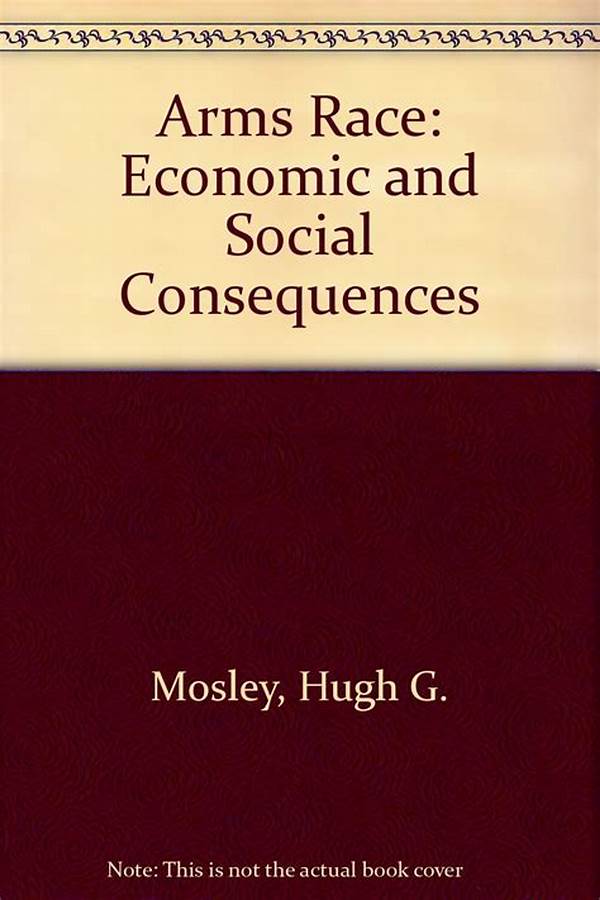The phenomenon of an arms race, characterized by the competitive accumulation of weapons and military capabilities between nations, has far-reaching economic consequences. It is a subject that commands the attention of policymakers, economists, and international relations experts alike. Understanding the economic implications of an arms race requires a comprehensive analysis of national budgets, international trade, and long-term fiscal strategies. This article delves into various aspects of the arms race economic consequences, offering a multi-faceted examination of its impact on participating countries and the global economy.
The Economic Impact of Arms Races
Arms race economic consequences manifest in several ways, starting with the direct financial burden on national economies. Countries engaged in arms races often allocate substantial portions of their national budgets to defense spending. This reallocates resources from vital public sectors such as healthcare, education, and infrastructure, potentially hindering overall economic development. The sustained expenditure required to keep pace with an adversary in an arms race can lead to increased national debt, placing a long-term fiscal strain on a nation. Consequently, the opportunity cost associated with military spending becomes significant, impacting economic growth and the well-being of the citizenry.
Moreover, the arms race economic consequences influence international trade dynamics. As nations prioritize funding for military advancements, their interaction in global trade can be altered. Countries may impose trade restrictions or engage in diplomatic conflicts, disrupting established trade patterns. The focus on defense can stifle innovation in non-military sectors, reducing competitiveness in the global marketplace. Additionally, arms races can lead to increased volatility in international markets, affecting currency stability and investment flows between nations. The economic interdependence of nations is thereby challenged, creating a complex environment that can hinder cooperative economic development.
The broader global economic consequences of arms races include the risk of regional instability, which can deter foreign investment and impact international economic partnerships. The uncertainty and potential for conflict inherent in arms races can lead to elevated risk premiums, impacting borrowing costs and dampening investor confidence. As such, the arms race economic consequences extend beyond immediate fiscal concerns, influencing long-term economic prospects and hindering efforts to achieve sustainable development.
Financial Burden and National Budgets
1. The arms race economic consequences create significant financial strain on national budgets, diverting funds from crucial sectors like health and education. This reallocation can suppress social welfare and hinder the overall quality of life in affected regions.
2. Engaging in an arms race can lead to the accumulation of national debt. Increased borrowing to fund defense expenditures impacts fiscal stability, limiting future economic policy options for nations involved in such races.
3. The opportunity costs associated with arms race economic consequences are substantial, as funds allocated to military endeavors could otherwise be invested in sectors promoting innovation and sustainable development.
4. Arms races also persuade economies to prioritize short-term military needs over long-term economic planning, further exacerbating the economic consequences. This focus can hamper a nation’s ability to adapt to changing global economic conditions.
5. The international financial markets may experience volatility due to arms races, as concerns about regional stability influence investor behavior and disrupt normal economic activities, highlighting the broader economic implications of these competitive dynamics.
Trade Dynamics and Innovation
The arms race economic consequences extend into the realm of international trade, altering global trade dynamics and affecting innovation. Nations embroiled in arms races often prioritize defense over other economic ventures, leading to a reallocation of resources that might otherwise have propelled technological advancements in civilian sectors. This shift in priorities can impact a country’s competitive edge in the global market, as diminished innovation in non-military technology sectors can weaken overall economic performance. A focus on military capabilities instead of fostering a diverse range of industries can lead to a lack of adaptability and decreased resilience in the face of economic shifts.
Moreover, the arms race economic consequences include disruptions in trade relationships. Nations may implement protectionist policies or engage in economic sanctions in reaction to perceived threats, destabilizing established trade networks. The escalated tension can result in trade barriers, increased tariffs, and strained diplomatic relations, further complicating cross-border commercial engagements. Such disruptions not only affect the involved nations but also have a cascading effect on global trade patterns, influencing production chains and consumer markets worldwide. The intricate ties of the global economy thus become vulnerable to the unpredictable nature of arms races.
Long-Term Strategic Concerns
1. The arms race economic consequences present long-term strategic challenges, as nations must balance immediate military needs with sustainable economic planning, often facing trade-offs that affect long-term national priorities.
2. A significant consequence is the potential for regional conflicts, prompted by heightened military competition, that can destabilize entire regions and have profound ramifications on global economic stability.
3. Arms races can exacerbate inequality within nations, as defense spending diverts resources from social programs, leading to pronounced disparities in wealth and access to public services.
4. The increased national debt resulting from arms races can constrain future economic growth by limiting government spending flexibility and raising borrowing costs, impacting public investment opportunities.
5. There is also a risk of perpetuating arms races, as economic dependencies on the defense sector create vested interests resistant to demilitarization; this entrenched stance continues to propagate arms race economic consequences.
6. Technological advancements in military capabilities often outpace regulatory frameworks, creating economic inefficiencies and ethical concerns that further burden the economic landscape.
7. Arms races may prompt nations to form military alliances, which have economic implications, potentially influencing international investment patterns and resource allocation strategies on a global scale.
8. The global nature of arms races means that economic consequences are not contained within national borders, affecting multilateral economic agreements and leading to potential revisions in international economic governance structures.
9. The inclusion of emerging economies in arms races can lead to a misallocation of their burgeoning economic resources, hindering their development trajectories by prioritizing military capabilities over socioeconomic growth.
10. Addressing the arms race economic consequences requires international cooperation, as mitigating these effects involves realigning national priorities towards collaborative security arrangements that reduce the need for competitive militarization.
The Socioeconomic Impact
The arms race economic consequences extend deeply into the socioeconomic fabric of nations involved in such competitive dynamics. Firstly, the diversion of funds from crucial public sectors, such as education and healthcare, due to increased defense spending can lead to the deterioration of social services. This decline impacts human capital development and can perpetuate cycles of poverty, limiting opportunities for individual and community advancement. The long-term socioeconomic impact is significant, as reduced access to quality education and healthcare impairs the potential for innovation and productivity, consequently stifling economic prosperity.
Furthermore, within societies, arms races can exacerbate existing inequalities. The concentration of resources toward military capabilities often benefits a limited segment of the population directly involved in the defense sector, while broader segments may experience reduced access to essential services. This disparity leads to heightened social tensions and can strain the social fabric, with economic inequality translating into broader social divisions. The arms race economic consequences thus extend beyond fiscal metrics, impacting societal cohesion and stability. Addressing these socioeconomic challenges requires re-evaluating the allocation of national resources to ensure balanced growth that supports both defense needs and socioeconomic advancement.
Role of International Policy
Addressing the arms race economic consequences necessitates a well-coordinated international policy approach. Countries embroiled in arms races should engage in diplomatic efforts to establish mutual trust and reduce tensions, potentially leading to disarmament agreements that can alleviate the economic burdens of military competition. By focusing on transparent communication and confidence-building measures, nations can shift from adversarial stances to cooperative security frameworks. This transition would allow governments to reallocate resources towards developmental initiatives, fostering economic growth that is sustainable and equitable.
Additionally, international organizations play a crucial role in mitigating arms race economic consequences. By advocating for disarmament and promoting economic cooperation, these entities can provide platforms for dialogue and negotiation. Their efforts can lead to the implementation of multilateral agreements that not only reduce defense spending but also encourage economic development. Such collaboration, backed by international policies and agreements, offers a pathway towards reducing tensions and fostering a stable economic environment. By aligning economic policies with peace-building measures, nations can work towards diminishing the adverse economic impacts of arms races and promoting global economic security and stability.
Conclusion: Navigating the Future
In conclusion, the arms race economic consequences are multifaceted and pose significant challenges to both national and global economic stability. From increased defense spending that strains national budgets to the long-term strategic implications that affect international relations, these consequences require comprehensive strategies to navigate effectively. The challenges of arms races are not insurmountable; through diplomatic efforts, international policy coordination, and a shift towards cooperative security, nations can mitigate the adverse economic impacts.
To this end, fostering an environment that promotes peace over competition is essential. Investment in dialogues and confidence-building measures, alongside the reallocation of resources towards sustainable development, can contribute to breaking the cyclical nature of arms races. It is imperative for nations to recognize the interlinked nature of economic and security policies and strive for solutions that not only address immediate concerns but also contribute to long-term prosperity. By doing so, the global community can work towards a future where economic growth and security are not mutually exclusive, paving the way for stability and progress in an increasingly interconnected world.





